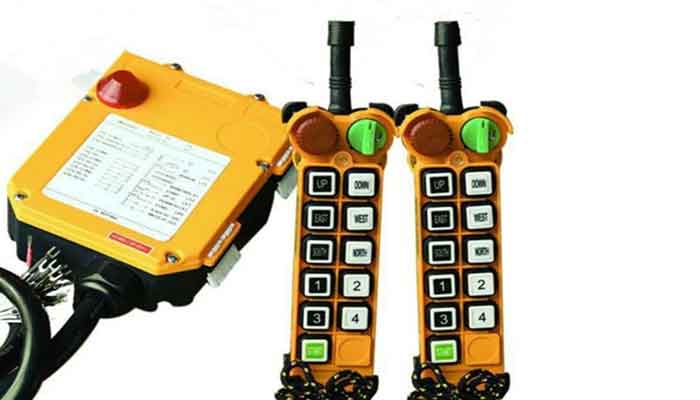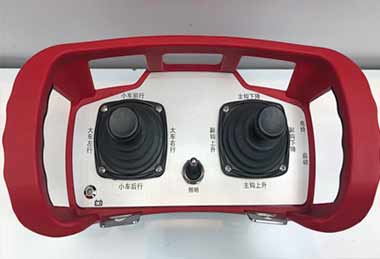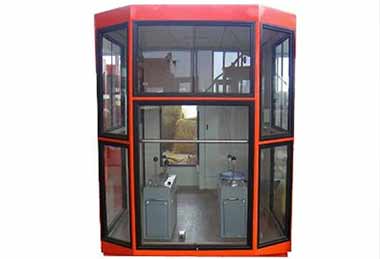
Why to Choose Radio Remote Control for Your Overhead Crane?
Why to select remote control for your overhead travelling crane? How does radio remote control work? What's advantages crane remote control? Check now!
How Do Crane Radio Remote Controls Work?
Crane Radio Remote Controls work by radio as its name suggested. A transmitter and a receiver are used to make them work together. Whenever a button is pressed, a joystick is moved, or a switch is flicked, the transmitter in the controller delivers a data packet.A receiver will receive the data packet following the action's completion and transmission.The receiver will take action based on what the data packet indicates.The radio frequency used to transmit the data packet is typically approximately 433 MHz (this is a common operating frequency).
Your remote control's operating frequency is very crucial.You don't want to be using a frequency where any other device could interfere with your operation.When crane radio remote controls were originally incorporated into overhead crane systems, interference was a significant problem.
Thankfully, all of those problems have been resolved, and now it is commonplace for these remote controls to function on a secure frequency.Some devices will also come with a special code and key, ensuring that a given transmitter will only function with a given receiver.
The Advantages of Crane Radio Remote Control Systems
Affordability
The cost of contemporary Crane Radio Remote Control systems is a significant improvement. These systems used to be expensive, but contemporary ones are incredibly economical. Crane radio remote control systems are now far more affordable than pendant systems.
Higher Worker Safety
A remote control system offers two significant safety advantages.1. The employee need not be in close proximity to the workload.2. Their visibility has significantly risen. Both of these advantages improve the employee's personal safety, which is beneficial for both the employee and the employer.
Increased Efficiency
Systems for controlling cranes remotely are incredibly effective tools. Due to the improved visibility they offer, they typically enable one worker to do the duties of two or three.A less evident advantage is that the process becomes simpler to assess when your employee physically distances themselves from it.It is also simple to improve upon if it is simple to examine.Remote crane systems make it possible for a better process in addition to making transportation easier.
Growing Business Profits
Crane remote systems give your company a chance to improve profitability.This may be accomplished by reducing the number of people needed to complete a task, preventing workplace accidents that impede output, or improving the efficiency of your production procedures.Even one of those things would boost your company's earnings or cut costs.
Diagnostics and Data
It should come as no surprise that contemporary remote controls are designed to give a wealth of information.Many of these systems are capable of giving service technicians data such as diagnostics or fault codes, runtime utilization, the quantity of picks or hooks made, and even the weight on the hook.It is now simpler thanks to all of this information to monitor the effectiveness of your manufacturing and carry out routine crane maintenance.
Are There Any Drawbacks to Crane Radio Remote Controls?
The disadvantages of Crane Radio Remote Controls are primarily determined by the type of overhead travelling crane with which they are matched or paired.Crane Radio Remote Controls may not be the best option for cranes that are rarely used, such as class A and class B cranes, because they rely on rechargeable batteries.As a result, if you don't use your overhead crane frequently, your remote control batteries are unlikely to be charged when you need them.However, there is no disadvantage if you use your crane frequently and keep your remote charged.Another consideration is that the handheld device is more prone to wear and tear or damage.
While it is true that you can drop the remote enough times to damage it, you can easily avoid dropping the remote.Many remotes come with lanyard attachments that can hook to a worker's belt, making them impossible to drop.To withstand the occasional fall, remote controls are typically made of hard plastic and rubber.There are also protective pouches and cases to keep debris and drops at bay.In terms of safety and versatility, the disadvantages outweigh any pendant alternative.
Pendent control vs. Remote Control
Although most manufacturers use pendant systems, Crane Radio Remote Control systems are even safer and occasionally required to avoid dangers like fumes, heat, and radiation.Remote systems reduce the operator's exposure to hazardous working conditions by allowing them to stand far from the crane.Additionally, the operator may do lifts from a superior view point, which improves both their own and the factory's operational safety.Because of the improved visibility, you can operate the lift with just one operator rather than teams of two or three.

Radio remote crane control for overhead crane
Remote control for your overhead crane
The remote controllers are exceptionally sturdy, which makes them ideal for production applications, and they are highly adjustable to whatever our customers' demands are. The receivers are very simple to install because they are also quite lightweight and take up little room.
Where to install an industrial remote control system?
Here are some examples of lifting devices where we can install an industrial crane remote control system:
- Types of remote control cranes - Overhead crane, gantry crane , jib cranes & other types of hoists, etc.
- Types of crane attachments- C Hook, Sheet Lifter, Lifting Beam, Scissor Lifting Tongs, Paper Coil Lifting Tongs, Automatic Lifting Tongs, etc.
Crane Radio Remote Control systems have had a significant impact on increasing overhead crane efficiency and safety.Understanding the benefits of remote control systems and how they work is not difficult. It can be difficult to determine what type of remote control system would make your overhead crane safer and more efficient.As a result of the high demand for remote control overhead cranes among our clients, we have a lot of experience offering these systems to a variety of commercial enterprises.






